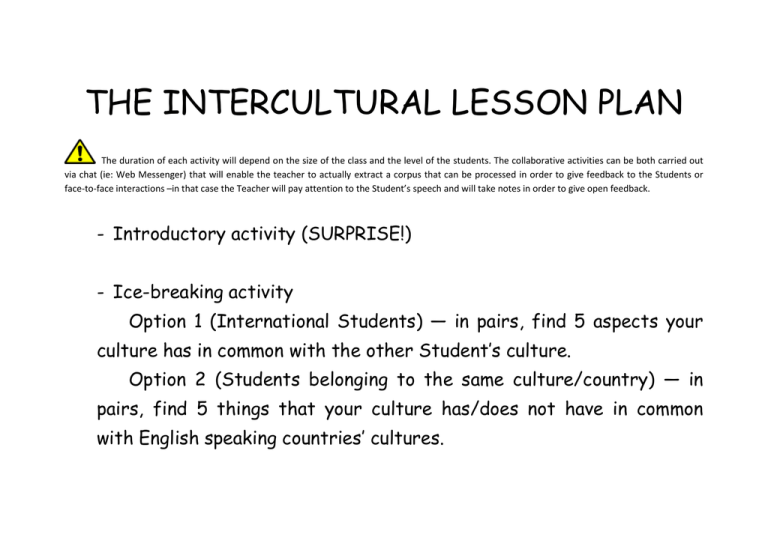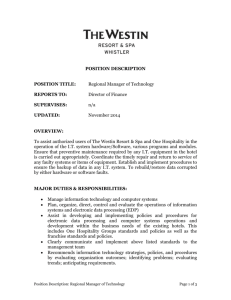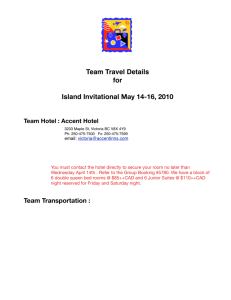Ester Saiz de Lobado
advertisement

THE INTERCULTURAL LESSON PLAN The duration of each activity will depend on the size of the class and the level of the students. The collaborative activities can be both carried out via chat (ie: Web Messenger) that will enable the teacher to actually extract a corpus that can be processed in order to give feedback to the Students or face-to-face interactions –in that case the Teacher will pay attention to the Student’s speech and will take notes in order to give open feedback. - Introductory activity (SURPRISE!) - Ice-breaking activity Option 1 (International Students) — in pairs, find 5 aspects your culture has in common with the other Student’s culture. Option 2 (Students belonging to the same culture/country) — in pairs, find 5 things that your culture has/does not have in common with English speaking countries’ cultures. Collaborative activity 1 - Each document explains key points of different cultures. Once you have read the document you need to decide, together with your partner, how to “mime” the culture that has been given to you. You will have 30 minutes to discuss it via chat (Web Messenger) in ENGLISH. After these 30 minutes, together with your partner, you will “mime” the culture and your peers will guess it. In this lesson plan we will include two examples. The information has been extracted from http://globaledge.msu.edu/ and When Cultures Collide by Richard D. Lewis - IRAN - History: The Sha was overthrown in 1979 by the Ayatollah Khomeini and Iran became an Islamic Republic. The Beatles performed in Iran in the 60’s. - Values: Islamic faith and values; traditional music and literature; respect of the wisdom of the old; politeness and clemency; hospitality; family; Design and pattern; seriousness; respect for the Islamic role of women. - Leadership: Spiritual leadership. - Space & Time: Iranians keep their distances more than Arabs; Punctual—respect for other people’s time. - Cultural factors in communication: Communication pattern talkative but not idle chatters courteous persuasive. - Listening habits: attentive listeners; admiration for “experts; they feel superior in their spiritual values. - Behaviour at Meetings and Negotiations: hospitality; latest technology; persuasion; the meetings might be broken by long prayer sessions. - Manners and taboos: limited body language; no alcohol; dietary restrictions; don’t shake women’s hands; use of the left hand forbidden for “clean” tasks. - How to empathize with Iranians: show respect; show dignity and seriousness in speech; praise their hospitality; offer state-of-the-arts technology; indicate your purpose and intentions; show courtesy; avoid political subjects; avoid too much body language and chatter; avoid giving gifts with the representation of a human face; don’t contradict yourself. Extracted from When Cultures Collide by Richard D. Lewis - SWITZERLAND - History: four languages; mountainous; 26 cantons; independent; neutral. - Values: polite; punctual; over-serious; law-abiding; obsessed by security; suspicious of all foreigners; cautious; hardworking; environmentally sensitive; pragmatic; anxious to control. - Leadership: Deep-rooted distrust of government; wealthy citizens. - Space & Time: since it is such a small country space is cherished; Swiss do not waste time. - Cultural factors in communication: polite, private. - Listening habits: good listeners; conservative; persuasion does not work. - Behaviour at Meetings and Negotiations: self-confident; not aggressive business people; confident. - Manners and Taboos: Heavy drinkers, manners customs and festivals that vary from one canton to another; taboos include boasting, undue curiosity, invasion of privacy and unpunctuality. - How to empathize with the Swiss: correctness and propriety; no urgency to “join Europe”, neutrality; multicultural balance. When engaging in business one should show dependency, conformism, address their worries and problems, financial solidity. Avoid showing one is bored, breaking laws, rules and regulations, eccentric behaviour. Extracted from When Cultures Collide by Richard D. Lewis Collaborative activity 2 (1) You and your friend have stayed at a casa andaluza (hotel) in Seville. The place is horrible and you are not happy at all with the services provided. You have made a list of things that are wrong with your accommodation. You and your partner have four images picturing irregularities at the hotel. Of these four things, both of you have seen exactly two. Describe each of your pictures so that you can figure out which three things you have both realized. Once you agree on these three things, compose a complaint letter addressed to the hotel management. (2) You and your friend have stayed at a casa andaluza (hotel) in Seville. The place is horrible and you are not happy at all with the services provided. You have made a list of things that are wrong with your accommodation. You and your partner have four images picturing irregularities at the hotel. Of these four things, both of you have seen exactly two. Describe each of your pictures so that you can figure out which three things you have both realized. Once you agree on these three things, compose a complaint letter addressed to the hotel management.






